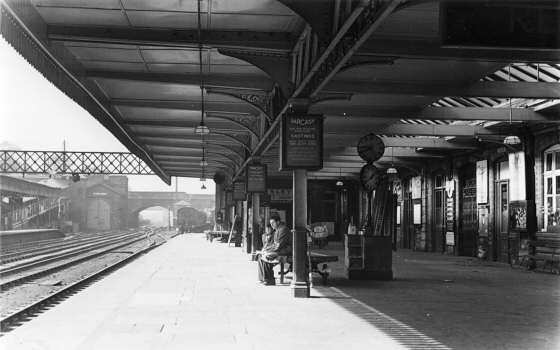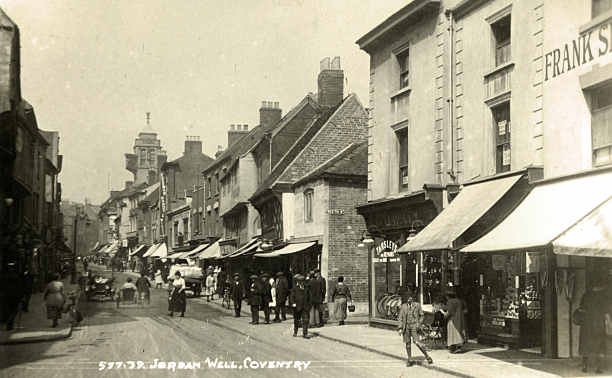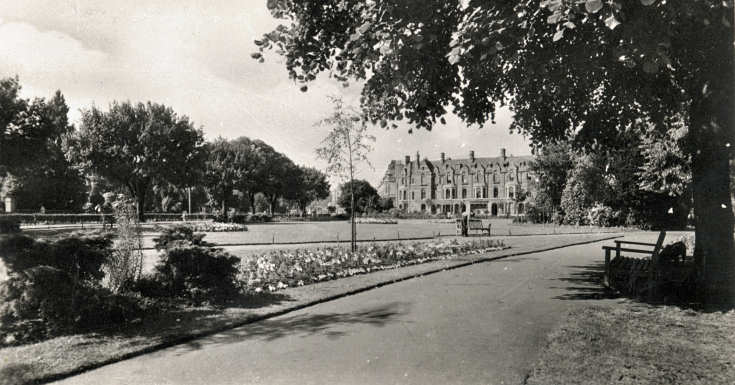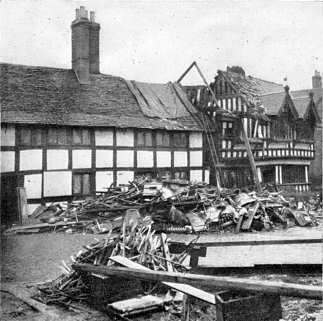|
Index...
|
For many years Mike Spellacy has wanted to write a biography or diary of his life's memories, and now he has. He's put together a comprehensive chronicle of his lifetime's major happenings - observations and feelings about his experiences, and what he saw and lived through.
 mention this specifically because it evokes powerful memories. The glorious days of steam some would say - and perhaps they're right. I spent many hours wandering the railway lines, hanging over the bridges, climbing in empty carriages, and enjoying the spectacle every time an engine went by. We were quite close to the station, and dad rented a small lock-up garage adjacent to the Iron bridge that was sited at the south end of the station. When I was alone and bored it was my destination.
mention this specifically because it evokes powerful memories. The glorious days of steam some would say - and perhaps they're right. I spent many hours wandering the railway lines, hanging over the bridges, climbing in empty carriages, and enjoying the spectacle every time an engine went by. We were quite close to the station, and dad rented a small lock-up garage adjacent to the Iron bridge that was sited at the south end of the station. When I was alone and bored it was my destination.
I could climb over and into the lock-up quite easily and I recall two cars that were homed there at different times. One was a 1939 Hillman Minx which dad hand painted in battleship grey paint (pinched from work).
The iron bridge over the railway line was so low I was able to hang over it letting the steam and smoke wash over me as the trains passed through. I also used to walk across the bridge on the parapet with a drop to the lines one side of me. How incredibly dangerous that was when I think about it.
 Coventry Station how Mike would've remembered it in 1952.
Coventry Station how Mike would've remembered it in 1952.
One startling experience I had at the station was one day when I read that Laurel and Hardy, who were to appear at the Hippodrome, were arriving by rail. The front of the station had huge crowds waiting, so I went to my iron bridge at the south end and I was flabbergasted when a huge open-topped Humber pulled up at the south gate right in front of me. They had decided to pick them up there rather than face the huge crowds. I was there with only a handful of people to witness Laurel and Hardy get into the car within a few feet of me. Fantastic! They were both beaming and they looked back and waved. A never to be forgotten experience. I wonder if they even noticed the scruffy little 10-year-old standing there.
On days when I was alone I remember also learning the geography of Coventry by walking miles and miles and miles of streets. That's how I got to know where every cinema was and its name. I would walk to my Auntie's at Canley, Radford, and Tile Hill, taking the roundabout route. I remember my dad telling me he worked at Coventry Radiators and I walked until I found it. He wouldn't have been there because he worked the night shift and would have been home in bed. That's another reason we didn't go home, we didn't dare. I remember once going home for whatever reason and he woke up and shouted at us. He called us 'Cowsons'?? I never found out what this meant.
Mum was out at work as well, and I remember once standing outside the shop where she worked once to catch a glimpse of her. It was a general store in Jordan Well opposite the Gaumont Cinema. It took me ages to spot her, and it was because I didn't recognise her in her white outfit with a hat on. Next door was an opticians called 'Hugh Seymour'. I figured this was a wind-up, but I never found out.
My Uncle Burt was a master baker, and he worked at Gladding's Bakery in St. John's Street. The smell that emanated from The Bakers was to die for, and I've never ever smelled the like again except once when my Auntie Margaret baked some bread once when we visited her in Leicester. For some reason bread baking doesn't smell like it used to any more. Why? What has changed?
St. John's Street was to my mind a very unique street and the detail sticks clearly in my memory; the houses particularly, and the courtyards. It was an appalling thing that happened when Coventry Council pulled down and destroyed for ever this wonderful piece of history. My guess is that it was built in the 15th/16th century, and lots of the houses echoed what you can now see in old Suffolk. Gabled houses with lattice windows that overhung the cobbled street below, and you could almost touch someone's hand if they leaned out of the window opposite. Entries that lead into open courtyards at the rear with rows of two up / two downs each side and a well in the middle of the courtyard and one outside loo to each three or four houses. Fantastic! And I remember it so well.... my friend Alfie Nutting's mum standing at the door in her white pinny and her red grinning face.
This was life as it was three hundred years ago and it hadn't changed. I'm so thrilled that I witnessed it, lived it, saw it and breathed it.
 Jordan Well before the war. Although this street suffered during the blitz, many of these shops survived and would've still stood during Mike's childhood.
Jordan Well before the war. Although this street suffered during the blitz, many of these shops survived and would've still stood during Mike's childhood.On Coronation day they had a party in the courtyard, with long wooden tables down the centre with lots of goodies and flags flying. I was there and I remember eating a bowl of strawberry jelly. I have only that picture left in my mind. I don't remember who was there or what was said.
St. John's Street ran only a short distance when it joined another road and if you turned left it ran down and joined Jordan Well. Along that road was the small factory that made Lea Francis Cars, and I can remember them parked on the pavements with guys working on them. They would have been new 14hp models, and I remember one with a shooting brake body. Hand built cars much like Alvis, and it's great to see so many have survived to this day.
 ack to my house, and turning left from our front door St. Patrick's Road continued with a bend to the right. In the middle of this bend during the war a massive bomb was dropped. Ten or twelve houses on our side were totally de-faced and virtually gutted. These were boarded up with tarpaulin sheets and they became my 'playground' for some 6/7 years as I grew up. On the opposite side two of the houses were totally blown away and two new houses of identical design were built on the same sites.
ack to my house, and turning left from our front door St. Patrick's Road continued with a bend to the right. In the middle of this bend during the war a massive bomb was dropped. Ten or twelve houses on our side were totally de-faced and virtually gutted. These were boarded up with tarpaulin sheets and they became my 'playground' for some 6/7 years as I grew up. On the opposite side two of the houses were totally blown away and two new houses of identical design were built on the same sites.
The road continued for half a mile and arrived at a massive junction at a place called Greyfriars' Green. Traffic lights controlled this complex, and to the immediate left a road ran to Coventry Railway Station. Second left was a lovely wide road that was the Kenilworth Road. Straight over went a very busy road that headed towards north Coventry and Birmingham, and was the continuation of the A5.
 Greyfriars Green around the 1950s.
Greyfriars Green around the 1950s.This whole area including the Kenilworth road and around the Station etc. was clearly a high-class area in terms of the residential and period property that abounded. Gorgeous large detached properties, many empty as I recall them. Solicitors and all sorts of professional people had offices surrounding the beautiful Greyfriars' Green, which was later to be utterly torn apart and destroyed by Coventry Council to build a dreadful Inner Ring Road. Sad day, and one which they should be ashamed of. I knew most of the beautiful houses running up and off the Kenilworth road because I was a paperboy for a newsagent on Greyfriars' Green. This green was a delight in summer, with shoppers enjoying the exclusive high-class shops that adorned the road at the back of it. The Kenilworth Road ran into Broadgate (via Warwick Road & Hertford Street), passing the Empire Cinema on route.
In the 40s and 50s there must have been 20 to 30 Cinemas in Coventry, all active and busy, and I got to know them all and where they were. The Gaumont, the Crown, the Scala, to name but a few.
Opposite our house was the Labour Exchange - an imposing building built between the wars and not touched by the blitz. It still stands to this day. Its broad pavement front was where I learned to roller skate and spent many an hour so doing.
 Ford's Hospital where Mike used to pass by, shown here after the blitz. By the time he was 14 years old, this wonderful old almshouse had been skilfully restored.
Ford's Hospital where Mike used to pass by, shown here after the blitz. By the time he was 14 years old, this wonderful old almshouse had been skilfully restored.
To its right was a road that ran in towards the city centre, and then through little alley-style streets that were very mid-Victorian or before. It was there that the 16th century gabled almshouse stood (Ford's Hospital, right), and still does today. In my day it was a boarded up wreck, amazingly untouched by bombs. Another wreck close by was one of the three spires which was open, and a schoolboys delight to roam around in. We could climb up to the first parapet via the inner circular stairs and view the whole city.
We had to be careful in this area because the 'Fenton' gang lived nearby - a notorious family who regularly 'bashed up' anyone passing by. My ticket to pass was knowing one of the gang called Billy Fenton, who was in my class.
To the right opposite the Labour Exchange was the area known as the recreation ground. A vast flattened area totally destroyed by the blitz. It was open to all travellers, and many down-and-outs stopped there, plus small travelling Fairs and Circuses, etc.
On the corner opposite the Labour Exchange was a small independent garage that was very pre-war with hand petrol pumps etc. Next to that was a small one-man band men's hairdressers ran by a repulsive middle-aged Victorian guy. Mum would send us there for our hair-cuts and he would knock us about, pull our ears, slap us on the head to sit still, and give us a real head shaving with a blunt hand shaver. Mum would never come with us because she knew what he was like and wouldn't face up to him. We came out in tears every time with bits of plaster everywhere.
Website by Rob Orland © 2002 to 2026